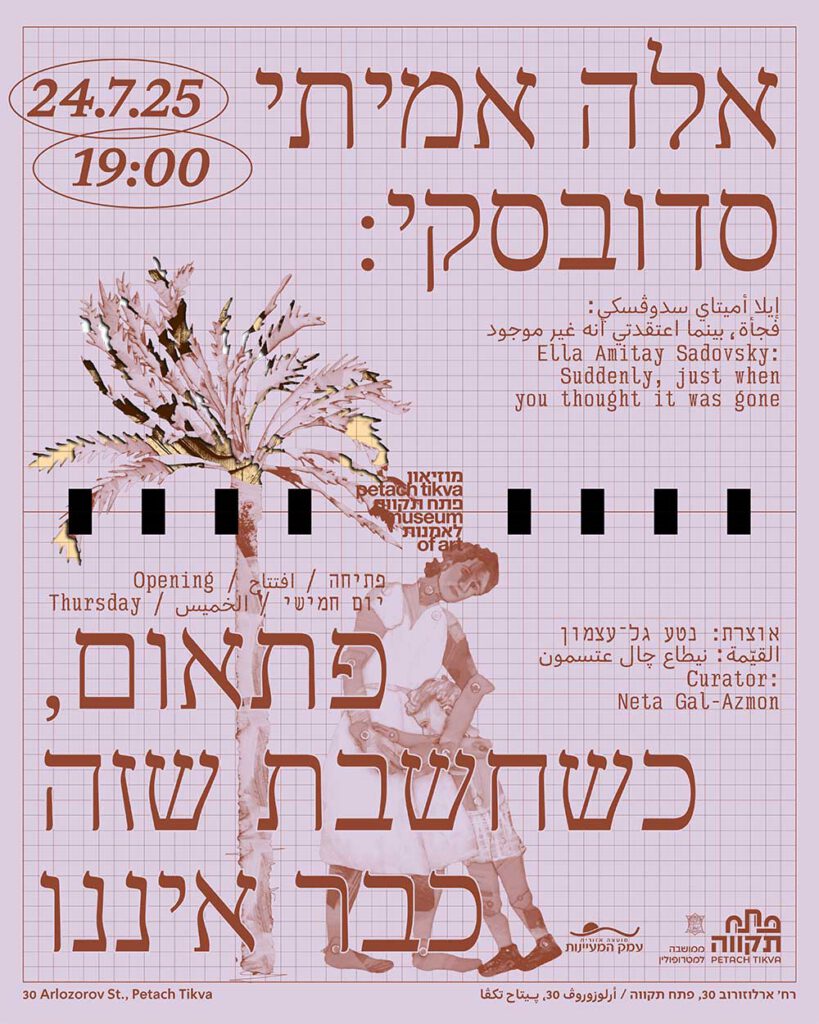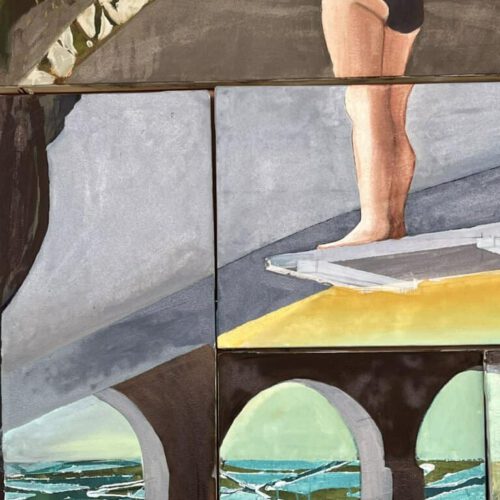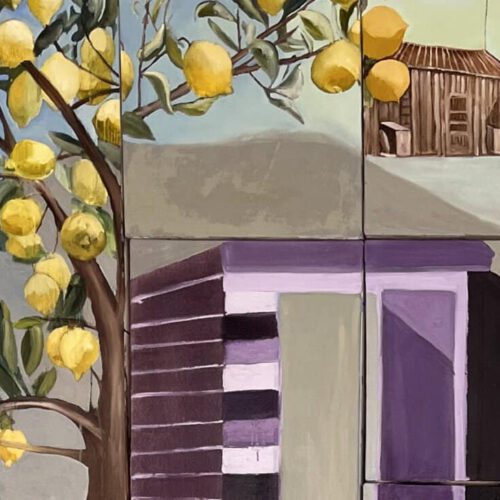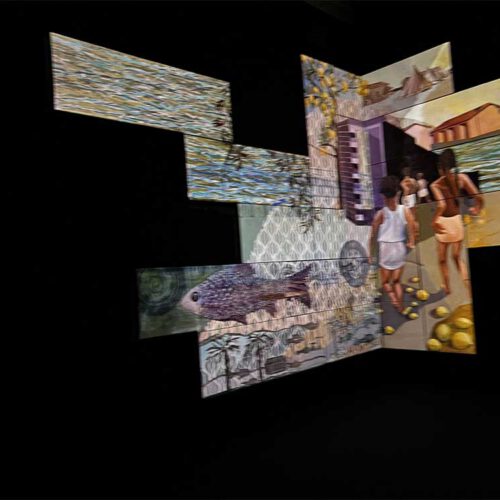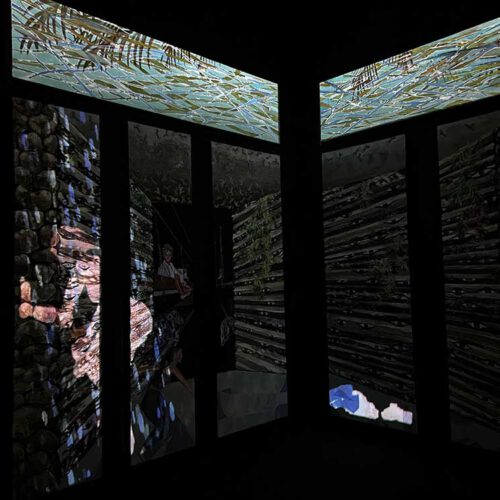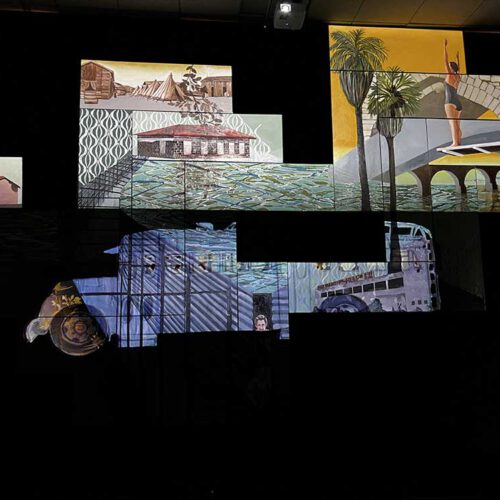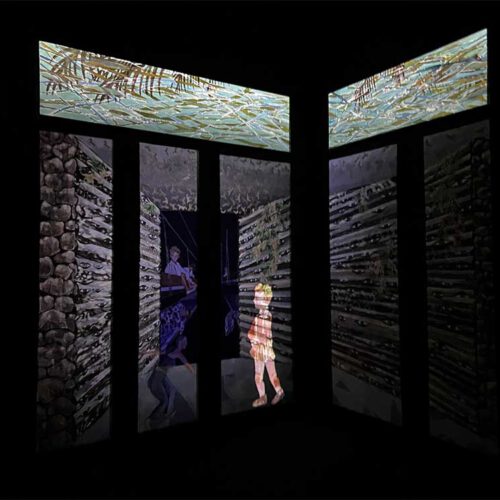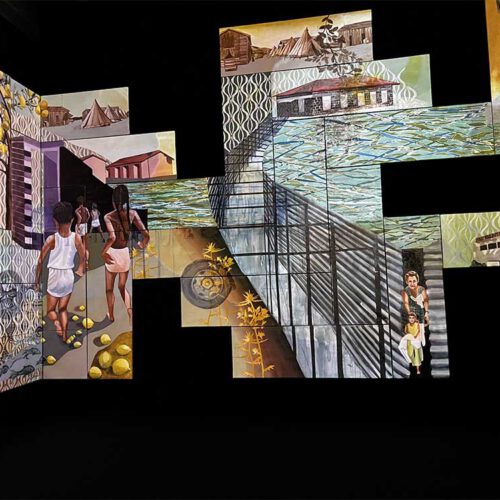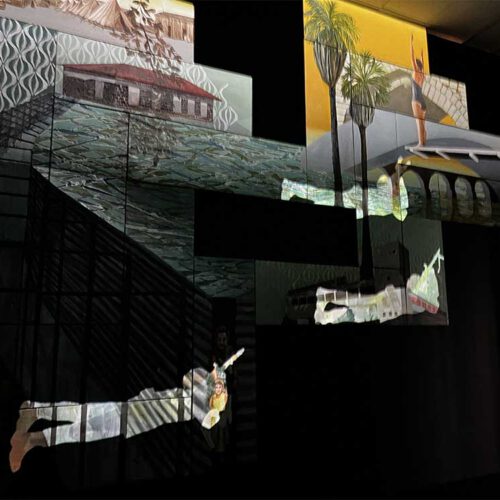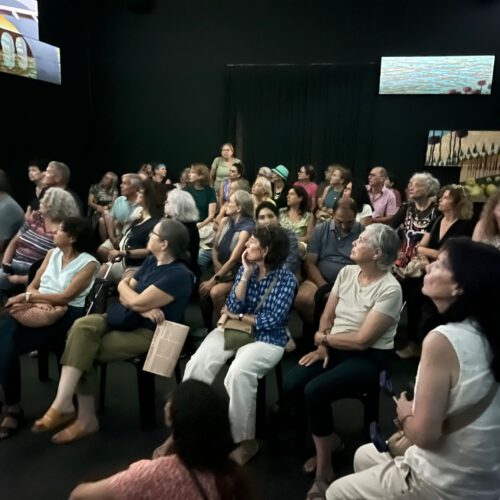Mixed media on canvas and stop-motion animation, four channels, 9 min
Ella Amitay Sadovsky’s installation was realized using a technique new to her work, combining sound and video animation projected onto a surface of paintings. Composed of layered paintings through gluing and subtraction, at times interwoven with textiles, the collage, synonymous with her practice, is now enriched with additional, immaterial strata. For the first time, the animated projections serve as the sole source of light illuminating the paintings.
The projected animation was crafted using stop-motion techniques, based on dolls made from painted cardboard cutouts, connected with joints that allow for movement. The figures were photographed frame by frame, edited into a sequence, and projected into a darkened space, conjuring the magic-lantern visions of childhood in the kibbutz. The soundtrack is perceived as an added layer, enveloping the scene, blending a cappella singing with choir singing from the archive of Kibbutz Gesher, where Amitay Sadovsky grew up. This intricate, multi-layered multimedia installation of imagery mirrors the dense strata of memory that preoccupy her.
In her works, Amitay Sadovsky returns to foundational experiences etched in her childhood—inscribed in the very flesh of her forming soul. The emotions of the girl she was back then, when her capacity for representation was not yet fully awakened, now find a late expression in adulthood, as long-repressed, threatening content rises to the surface to take shape in the present. The events of October 7, 2023 sparked a “return of the repressed,” summoning
early memories from the years of the War of Attrition—memories that left their imprint on the tender dawn of her life. Her works trace a journey of a life lived in liminal zones—unfolding on the geographical border between past and present, the time of her kibbutz memories—and across thresholds within the domestic space itself.
The border emerges in her work as the waterline of the Jordan River, separating the upper, illuminated part of the installation (life above ground) from the lower, dark section, where inner wars rage and everything invoked by darkness stirs. Across the Jordan—on whose banks lies her kibbutz—lurks the unknown; the dangerous and threatening. The “bridge” (Heb.
gesher) in the kibbutz’s name evokes a yearning for union, embodied in the act of crossing. As the threshold to the Promised Land, the mythical Jordan River also symbolizes the liminal divide between the embryonic formation of the Jewish people and their sovereign presence in their land; between exile and homeland.
Another geographical boundary woven into Amitay Sadovsky’s work is the earth’s surface.
During the War of Attrition, for three whole years, life above ground, in the line of fire, was fraught with danger. As a result, significant parts of her childhood were pushed underground,
into the subterranean bomb shelter, far from sunlight. The need to seek safety in the earth’s depths appears to have shaped the sensitive mind, which Freud likened to an iceberg, its greatest mass submerged.
Amitay Sadovsky returns to events that unfolded from the age of four—the threshold at which autobiographical memory begins, preceded by what Freud called “infantile amnesia.” Experiences from this early time rarely crystallize into conscious recollections—mental representations that can be named and stored in memory. Alongside the visual impressions upon which Amitay Sadovsky draws, flickering unrepresented “memories” also emerge—memories to which access is limited, ostensibly seared into the body, manifesting as symptoms, behaviors, or nameless dread.
One of the figures appearing in the work is the artist’s grandmother, Tsili Amitai, deputy commander of a forward post in Kibbutz Gesher during the War of Independence. When the Arab Legion and the Jordanian army invaded the Jordan Valley, Tsili Amitai was left alone in that post after all the other combatants around her had been either wounded or killed. She appealed to the force’s deputy commander, who was holding a rear position, asking to be relieved of her post—but he ordered her to continue fighting. A rescue team arrived nearly 24 hours later to find her still holding the line, alone.
On the night of the attack, the kibbutz children were evacuated to a monastery in Haifa, among them Tsili’s own children: her fiveyear-old son Amos and infant daughter Yael, accompanied by her husband, Avraham. The evacuation was carried out on foot through the fields, under constant shelling. Along the way, in the vicinity of Yavne’el, Jordanian aircraft
attacked the convoy, but miraculously, all survived. Little Amos, unable to find his shoes, which he hid in the bunker’s wall, walked the entire way barefoot. Two years later, when the children returned to the kibbutz, he found his shoes just where he had hidden them.
The exhibition is based on archival research and personal testimonies from both the War of Independence and the War of Attrition. It brings to light, for the first time, the story of Tsili Amitai—a narrative that, unlike the oft-told tale of “Amos’s Shoes,” has never been recounted.
The exhibition’s title is drawn from the words of Haim Gouri in a conversation with Ari Shavit (Haaretz, 3.3.2000 [Hebrew]): “In this land, the past is always the most current thing—because it always comes back. And suddenly, just when you thought it was gone, it takes its revenge.”

